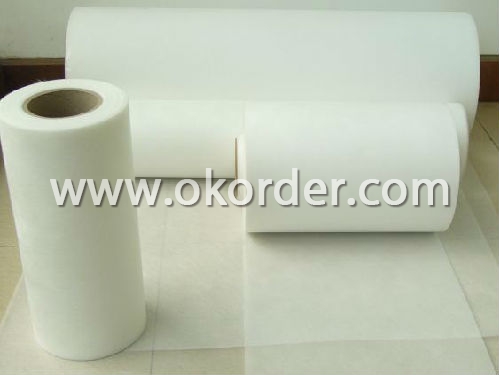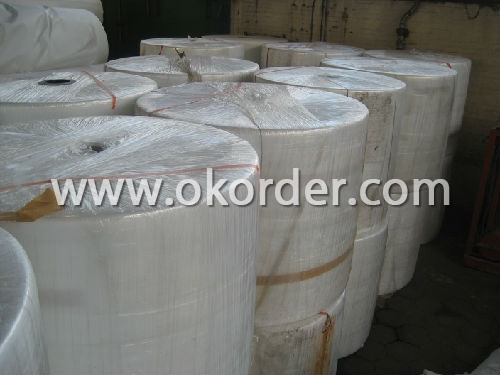C-Glass Surface Tissue
- Loading Port:
- China Main Port
- Payment Terms:
- TT or LC
- Min Order Qty:
- 2000Square Meter m²
- Supply Capability:
- 600000 Square Meter Per Month m²/month
OKorder Service Pledge
OKorder Financial Service
You Might Also Like
Packaging & Delivery of C-Glass Surface Tissue
Packaging Detail: | standard width: 1000mm/1040mm/1270mm, standard length: 300m usually packed in pp bag and then in cartons. Loading quantity is around 75000m2/20ft container or 189000m2/40" container. |
Delivery Detail: | 15 days after receipt of down payment |
Specifications of C-Glass Surface Tissue
1. fiberglass surfacing tissue
2.corrosion resistance
3. low binder content
4. good molding properties
5. Lloyd's approved
Introduction of C-Glass Surface Tissue
Fiberglass surface tissue is mainly used in the surface layers of FRP products. There are two types, winding series and hand lay-up series.
Winding series are mainly used on pipe and tank winding process. It can improve the product surface property on corrosion resistance, comprehensive strength, seepage resistance and longer service life.
Hand lay-up series are chiefly used in the products with complicated geometric curve. It has the advantages of good pattern fitness, quick resin permetion. It can raise the intensity and corrosion resistance of products
Characteristics of C-Glass Surface Tissue
Surface felt used in the fiberglass products, good permeability make resin instantly penetrate into, and eliminate the bubble and white stains phenomenon, it good effect for any sexual complex shape of products and mold surface, can cover up the cloth grain, improve surface finish and the permeability, and at the same time enhance interlaminar shear strength and surface toughness, make the products improve corrosion resistance, is manufacture high quality glass fiber reinforced plastic mold and the products of the essential supplies.
Application | Density (g/m2) | Moisture Content (%) | Binder Content (%) | Wetting time (%) | Tensile Strength MD(N/5CM) |
Winding | 20 | <0.2 | 7 | <8 | ≥20 |
30 | 6 | <10 | ≥25 | ||
50 | 6 | <16 | ≥40 | ||
Hand Lay UP | 30 | 7 | <10 | ≥20 | |
40 | 6 | <15 | ≥25 | ||
50 |
Product features of C-Glass Surface Tissue
The glass mat for FRP surface has a fiber dispersion, smooth surface, soft hand-feeling, low binder content , fast resin impregnation and good mould obedience which make it most applicable to other FRP molding processes such as press moulding , spray-up, centrufugal rotating moulding.
1 C-glass tissue used in machine or continuous operation paste hand made of fiberglass products (FRP), the plate, the pipeline, groove, cans, yacht, tub products.
2 E-glass fiberglass felt used for thin epoxy after COINS and electrical insulation products.
3 Alkali glass fiber thin felt used in battery of isolation, waterproofing roof, plasterboard is the panel, plastic floor and chemical pipe lined with leakage, corrosion quality materials.


- Q:Can fiberglass mat tissue be used for making insulation blankets?
- Indeed, insulation blankets can be created by utilizing fiberglass mat tissue. This lightweight and flexible material is frequently employed in insulation scenarios. It possesses remarkable thermal insulation characteristics, as well as the ability to withstand fire, moisture, and chemicals. Moreover, fiberglass mat tissue is effortlessly manageable and installable, rendering it an optimal selection for fabricating insulation blankets applicable across diverse industries, including construction, automotive, and aerospace.
- Q:Can fiberglass mat tissue be used for thermal insulation?
- Yes, fiberglass mat tissue can be used for thermal insulation. Fiberglass mat tissue is made from fine glass fibers that are woven together to form a strong and flexible material. It has excellent thermal insulation properties due to its low thermal conductivity and high resistance to heat transfer. Fiberglass mat tissue can be used to insulate walls, roofs, and other surfaces to prevent heat loss or gain. It is commonly used in the construction industry to improve energy efficiency and reduce heating or cooling costs. Additionally, fiberglass mat tissue is fire-resistant, moisture-resistant, and durable, making it suitable for various thermal insulation applications.
- Q:What are the different color options available for fiberglass mat tissue?
- Various color options are offered for fiberglass mat tissue, catering to different preferences and applications. White, gray, black, and beige are among the commonly available colors. These color choices offer versatility in design and aesthetics, allowing users to select a color that enhances their individual project needs. Factors like UV resistance and desired visibility or camouflage levels can also influence the color selection. In conclusion, the availability of diverse color options for fiberglass mat tissue grants users the flexibility and customization opportunities necessary to achieve their desired results.
- Q:How does fiberglass mat tissue perform in terms of acoustic insulation?
- When it comes to acoustic insulation, fiberglass mat tissue excels. Its fine fiber composition allows it to effectively absorb sound waves and minimize airborne noise transmission. The dense structure of the mat tissue enhances its soundproofing capabilities, making it a top choice for situations where noise control is essential. Furthermore, fiberglass mat tissue also boasts superior thermal insulation properties, further enhancing its acoustic insulation performance. In summary, this material is highly effective at reducing sound transmission and creating tranquil environments.
- Q:What is the shear strength of fiberglass mat tissue?
- Various factors, including the mat's thickness, the type and quality of the fiberglass material, and the manufacturing process, determine the shear strength of fiberglass mat tissue. Generally, fiberglass mat tissue possesses a higher shear strength compared to other materials. Typically, fiberglass mat tissue consists of multiple layers of glass fibers bonded together with a resin matrix. This combination yields a robust and long-lasting product. The high shear strength of fiberglass mat tissue enables it to withstand significant forces and resist deformation or failure under shear stress. To determine the specific shear strength of a particular fiberglass mat tissue, one must refer to the manufacturer's product specifications. These specifications outline the material's shear strength and other mechanical properties. It is crucial to note that the shear strength of fiberglass mat tissue may vary depending on the specific application and conditions. Factors like temperature, moisture, and exposure to chemicals can affect the material's performance. Therefore, it is advisable to consult the manufacturer's guidelines and seek advice from engineering experts to ensure the appropriate selection and application of fiberglass mat tissue for a given project.
- Q:How does fiberglass mat tissue compare to fiberglass insulation batts?
- Fiberglass mat tissue and fiberglass insulation batts serve different purposes and have distinct characteristics. Fiberglass mat tissue is primarily used as a reinforcement material in various applications such as roofing, wall coverings, and composite materials. It provides strength, durability, and improved dimensional stability to the finished product. On the other hand, fiberglass insulation batts are specifically designed for thermal insulation purposes, typically used in walls, ceilings, and attics to prevent heat transfer. They are engineered to trap air pockets within the material, providing excellent thermal resistance. While both products are made from fiberglass and offer certain insulation properties, their specific applications and performance differ significantly.
- Q:How does the cost of fiberglass mat tissue compare to other reinforcement materials?
- The cost of fiberglass mat tissue generally tends to be more affordable compared to other reinforcement materials. Fiberglass mat tissue is widely used in various industries, such as construction and automotive, due to its cost-effectiveness. Other reinforcement materials like carbon fiber or aramid fibers can be significantly more expensive, making fiberglass mat tissue a preferred choice for many applications that require reinforcement. Additionally, fiberglass mat tissue offers excellent strength and durability, making it a cost-effective solution for projects that require reliable reinforcement without breaking the budget.
- Q:What are the different finishing options available for fiberglass mat tissue?
- Some of the different finishing options available for fiberglass mat tissue include: resin coating, heat treatment, laminating, and surface texturing. These options can enhance the strength, durability, and appearance of the fiberglass mat tissue based on specific requirements and applications.
- Q:What is the thermal resistance of fiberglass mat tissue?
- The thermal resistance of fiberglass mat tissue depends on various factors such as the thickness of the mat, the density of the fibers, and the presence of any additional materials or coatings. Generally, fiberglass has a low thermal resistance, meaning it is a good conductor of heat. However, when used as insulation, the thickness and density of the fiberglass mat can increase its thermal resistance, making it more effective at reducing heat transfer. It is important to note that specific values for thermal resistance can vary depending on the specific product and application, so it is recommended to consult the manufacturer's specifications for accurate information.
- Q:Is fiberglass mat tissue resistant to alkalis?
- Yes, fiberglass mat tissue is resistant to alkalis.
1. Manufacturer Overview |
|
|---|---|
| Location | Hebei,China |
| Year Established | 2008 |
| Annual Output Value | Above US$20 Million |
| Main Markets | Mid East;Western Europe:South Asian |
| Company Certifications | ISO9001:2000;ISO14001:1996;GB/T28001:2001 |
2. Manufacturer Certificates |
|
|---|---|
| a) Certification Name | |
| Range | |
| Reference | |
| Validity Period | |
3. Manufacturer Capability |
|
|---|---|
| a)Trade Capacity | |
| Nearest Port | Tianjin |
| Export Percentage | 80% |
| No.of Employees in Trade Department | 350 People |
| Language Spoken: | English;Chinese;Korean |
| b)Factory Information | |
| Factory Size: | Above 100,000 square meters |
| No. of Production Lines | Above 12 |
| Contract Manufacturing | OEM Service Offered;Design Service Offered |
| Product Price Range | Average |
Send your message to us
C-Glass Surface Tissue
- Loading Port:
- China Main Port
- Payment Terms:
- TT or LC
- Min Order Qty:
- 2000Square Meter m²
- Supply Capability:
- 600000 Square Meter Per Month m²/month
OKorder Service Pledge
OKorder Financial Service
Similar products
New products
Hot products
Hot Searches
Related keywords




























